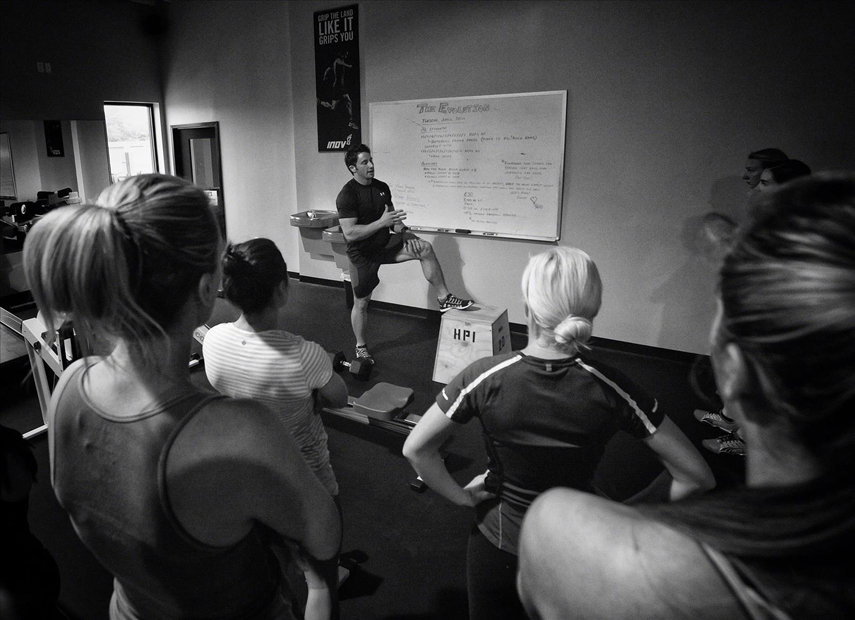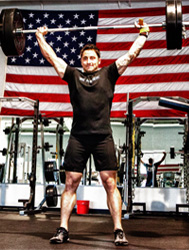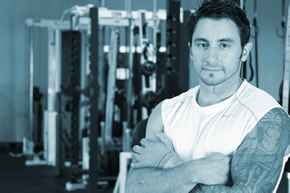“In the current environment, there’s so much out there and people don’t know what’s good and what’s not good,” says Rob Stock, founder and owner of The Human Performance Initiative, a cutting-edge gym in Virginia Beach, VA. “So they just assume if they walk out of there beaten and bloody, then they did something good to themselves. That’s not necessarily the case.”
While Stock is speaking about the aggressive fitness culture that inspired him to work safe training practices and recovery protocols into his core philosophy, the retired Navy SEAL understands the trials of blood and sweat at a level few ever will. First, surviving the grueling challenges to earn a spot on the SEALs teams; then, steeling himself for a long, painful rehabilitation after an explosion nearly tore off his left arm (Read Part I of “The Story of Rob Stock” here).
“I look back at [photos of the open wound] and then look at my arm and think ‘wow, this probably shouldn’t be attached.’”
Military doctors agreed. But despite specialists and surgeons recommending amputation, Stock pushed himself to the limits of recovery, gritting through a year-and-a-half of dedicated training with Shaun Huls (then a performance coach with the SEALS, now the Sports Science Coordinator for Chip Kelly and the Philadelphia Eagles). First, the two had to work around the total loss of grip-strength in Stock’s left hand.
“[At the beginning] a lot of the focus was on the legs and torso, and once I bridged into a position where I could start doing some pushing off the upper-body, then we moved into that,” says Stock. “Then, slowly, with the development of some of the aids I came up with we could finally do some upper body tool exercises, to where it is today where I can go in there any day and dead-lift over 400 pounds or jump on a pull-up bar and knock out some pull-ups.”
Despite that astonishing turnaround, the irreversible damage to Stock’s arm and hand was too significant for the SEAL to return to active duty. Before enlisting, Stock earned a mechanical engineering degree and worked as a project manager; facing a new career crossroads, rather than re-enter the corporate realm, Stock chose to follow his recent engagement with fitness and training.
“I took a pretty big interest in strength and conditioning after working with Shaun for so long,” says Stock. “So I started pursuing it, and then when I found out I was going to retire from the teams, I started looking for places to train — because I obviously wouldn’t have access to our facility any more over at the command.”
One of the tools available at the Naval facility was the Omegawave Pro system, which Huls and Stock used to monitor how he was responding to the intense stressors of his rehabilitation. When Stock originally went through BUD/S, however, the technology still hadn’t yet been adopted at the field or training level.
“(Now) the science comes in once you get to the teams, when you’re an actual operator and the focus directs back to ‘how can we keep this guy in the fight longer and keep him healthier’ versus maybe beating the crap out of themselves every day,” says Stock. “But when I went through BUD/S, it was very much gut-check, twenty-six weeks, game-on. And when you’re done, you’re done.”

The combined mission of training and education in action at HPI.
Now well-versed in the adaptation and recovery model, Stock sought to find local facilities that balanced guided programming with open individual workouts, looking for both an intense attitude and qualified instructors to demonstrate proper technique.
“We asked around, polled people, and found out that injury-rates were astronomical,” Stock says. “You have accountants with torn rotator cuffs, and I was like ‘this just isn’t right, this isn’t what it’s all about.’ You can still train and perform at a high level, but does someone who works forty-to-fifty hours a week in an office need to be doing smashes for time? Probably not.”
Stock came up with a business plan and broke ground on HPI. In addition to staying mindful of recovery protocols and avoiding preventable injuries, another founding principle of HPI is an open-door policy for injured veterans.
“I wanted a place where other guys like me who’ve gotten hurt downrange can come train pretty much free of charge. That’s one thing we do, there’s no questions asked. If they just want to come in and work out on their own they can, and if they want programming they can get that too,” Stock says. “I want a place for guys to come into that’s a safe-haven — they won’t be looked at funny because they might only have one leg, or a prosthetic, or whatever. They can just get in, do their thing, and get out.”

HPI also has an Omegawave Pro system on-site — though high-performing triathletes and endurance athletes have been the first to take advantage of the assessments, Stock remains confident that his regular clientele will soon see the potential applications for their own training programs.
“It’s been hard to get people to buy into programming that follows an Omegawave strategy, but I think if you get the right individuals who follow it and start performing at a better level and feel better — and, in some cases, actually start training less — then it’ll only be a matter of time.”
“I think what I did post-injury really highlights some of the technologies and different tools that are being used in the strength and conditioning world to get everyone from pro players to Special Forces operators back in the game,” Stock continues. “Unfortunately, I had such terrible nerve damage in my hand and arm from the blast that I was never able to return to full operational duty. And if I could’ve, believe me — I definitely would’ve.”
